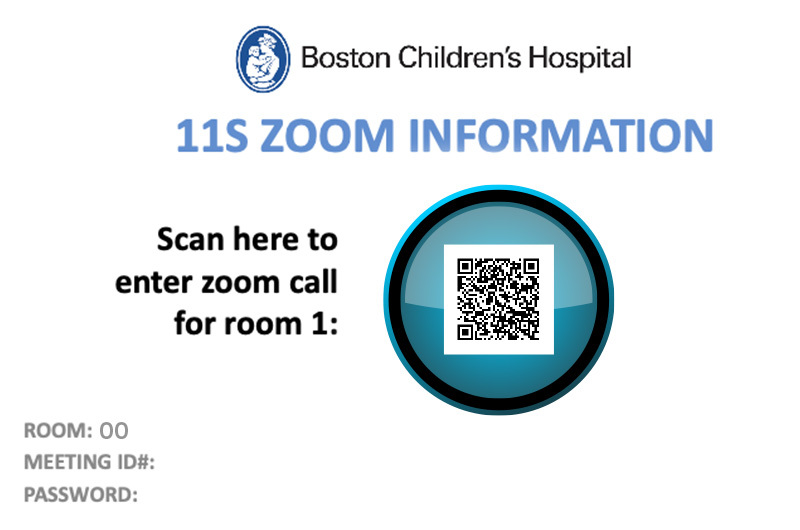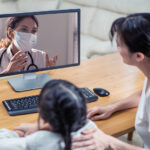In-hospital telehealth: Care innovation during the COVID-19 pandemic

The quick response, or QR, code — that square barcode symbol used by smartphone apps to link users with specific information — became an unexpected but essential tool for patient care at Boston Children’s Hospital in early spring.
When the first patients with COVID-19 arrived, it quickly became clear that health care providers needed safer ways to involve everyone in their care while limiting in-person meetings or large gatherings.
“Our initial goal was to find a way to help health care providers, both in the hospital and those who couldn’t be in the hospital, communicate with patients who had COVID-19,” says Jonathan Hron, MD, associate chief medical information officer at Boston Children’s, who knew restrictions would limit physical access to patient rooms. “We wanted to create a system that would give everybody the ability to communicate with that patient and family in a way that allowed them to do their job and provide the very best care for that patient.”
Scanning QR codes opens up Zoom link
To answer that challenge, a team of physicians and IT professionals at Boston Children’s launched an innovative meeting strategy utilizing the QR code and the Zoom online meeting service. The end result: an in-hospital videoconferencing system that anybody could join via a Zoom meeting to connect with a patient and their family. All they needed was a patient-specific password.

The only tools required are a tablet or smartphone loaded with the Zoom app. “In a bring-your-own-device approach, one just holds it up to the QR code and it opens the Zoom app for that meeting session for that patient in that room,” says co-developer Chase Parsons, DO, MBI, informatics lead for Clinical Decision Support and Prescriber Education at Boston Children’s. “Entering the password brings you into the confidential meeting.”
The team published a paper describing this new tool in May 2020.
Part of the pandemic telehealth boom
Typically, services like Zoom, Skype, or FaceTime are not acceptable for health care providers to discuss private patient information. But in March 2020, the U.S. Department of Health and Human Services adjusted telehealth guidelines to serve patients and caregivers through the COVID-19 pandemic.
“We immediately saw that we could use Zoom in a safe, private way,” says Parsons. Within five days of devising the program, the team held its first QR code Zoom meeting. Within the first full week, the team logged 50 Zoom patient meetings. That number rose to 350 in April at the height of the spring COVID-19 wave in Boston.
“Once we saw how well it worked, we knew we had to offer it to all patients in the hospital, not just those with COVID-19,” he says, a practice that continues at Boston Children’s. To date, the tool has been used in over 5,000 inpatient telehealth sessions with over 270,000 minutes logged.
Expands family and physician involvement
Along with minimizing exposure to the virus, the QR code Zoom tool has increased participation in patient meetings. More sub-specialists are available to attend from their homes or other locations in the hospital. And family members can participate who might not otherwise because of work schedules or caring for another family member.
“We soon learned that we could include input from health care providers outside of Boston Children’s, such as a primary care physician, the family pediatrician, or a clinician at another hospital,” says Hron. “And it has been well-received by patients and their families.”
The tool works even if one doesn’t have the QR code. If you are notified of a meeting, as long as you have the Zoom app on your device, you can enter or click on the meeting link, type in the password, and you’re in the meeting.
Physicians appreciate reduced exposure
The team surveyed more than 70 physicians, interpreters, social workers, child life specialists, and other clinicians to get their feedback.
“They really appreciated that they could do their job and also maintain physical distance,” explains Parsons. “It allows them to still interact with patients but also minimize the number of times they’re going in and out of a room to protect themselves, that family, and all of the other patients they are taking care of.” They also felt the Zoom meeting was much more engaging as opposed to a telephone call.
Potential nationwide use
Looking forward, the team hopes that permanent regulatory reform will help ensure programs like this can continue beyond the current pandemic. Says Hron, “So many of our departments were able to use it successfully — particularly those that rely heavily on visual exams or patient history — that we hope this kind of videoconferencing tool will be used more widely throughout not only Boston Children’s, but also at other hospitals.”
Learn more about Boston Children’s response to COVID-19
Related Posts :
-

Virtual visits give Weston time to grow and thrive
For many kids and parents, staying home during the COVID-19 pandemic was a challenge. But for Weston Mahady and his ...
-

Making autism evaluations accessible: Boston Children’s tests virtual options
At this time the virtual autism diagnosis program is only available to internal Boston Children's Hospital primary care patients who ...
-

(Virtually) visiting the home to help control childhood asthma
Many children have difficulty taking their asthma medicine on a regular basis. Sometimes it’s a matter of feeling well ...
-

We speak your language: Helping non-English-speaking families receive the best care
Visiting a health care provider requires a fair amount of communication, whether for scheduling an appointment, receiving care, or understanding ...





